GEOMETRY PRACTICE QUESTIONS FOR SAT
Subscribe to our ▶️ YouTube channel 🔴 for the latest videos, updates, and tips.
Problem 1 :
In the figure below, x =
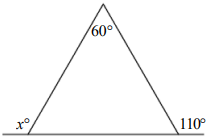
Solution :
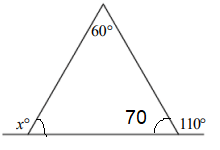
Sum of interior angles of the triangle = 180
60 + 70 + 180 - x = 180
130 + 180 - x = 180
130 + 180 - 180 = x
x = 130
Problem 2 :

In the figure above, x = 2z and y = 3z . What is the value of z ?
(A) 24 (B) 30 (C) 36 (D) 54 (E) 60
Solution :
Here x and y are supplementary angles.
x + y = 180
2z + 3z = 180
5z = 180
z = 180/5
z = 36
Problem 3 :

In the figure above, what is in terms of y?
(A) 150 - y (B) 150 + y (C) 80 + y (D) 30 + y (E) 30 - x
Solution :
Sum of interior angles of the triangle = 180
x + y + 30 = 180
x + y = 180 - 30
x + y = 150
x = 150 - y
Problem 4 :
The angles of a triangle are in the ratio of 2:3:4. What is the degree measure of the largest angle?
Solution :
Interior angles of the triangle is in the ratio 2 : 3 : 4
So, the angles will be 2x , 3x and 4x
2x + 3x + 4x = 180
9x = 180
x = 180/9
x = 20
Largest angle = 4x ==> 4(20) ==> 80
Problem 5 :
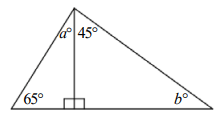
In the figure above, what is the value of a + b?
(A) 45 (B) 70 (C) 90 (D) 145 (E) 170
Solution :
Here angle b should be 45 degree.
The triangle in the left, the sum of interior angles is 180
65 + a + 90 = 180
65 + a = 180 - 90
65 + a = 90
a = 90 - 65
a = 25
a + b = 25 + 45
a + b = 70
Problem 6 :
If two sides of a triangle are 8 and 5, each of the following could be the measure of the third side EXCEPT
(A) 4 (B) 5 (C) 8 (D) 12 (E) 13
Solution :
If a, b and c are sides of the triangle, it should satisfy the triangle inequality theorem.
Let a = 8, b = 5
|
If 3rd side c = 4 8 + 5 > 4 8 + 4 > 5 5 + 4 > 8 True |
If 3rd side c = 5 8 + 5 > 5 5 + 5 > 8 True |
If 3rd side c = 8 8 + 5 > 8 8 + 8 > 5 True |
|
If 3rd side c = 12 8 + 5 > 12 8 + 12 > 5 12 + 5 > 8 True |
If 3rd side c = 13 8 + 5 > 13 False |
So, option E is correct.
Problem 7 :
If the area of a right triangle is 15, what is its perimeter?
(A) 11 (B) 15 (C) 16 (D) 17
(E) The answer cannot be determined from the information provided.
Solution :
To find the perimeter of any right triangle, we should know about all three sides. From the given information, area of right triangle is 15.
1/2 x base x height = 15
base x height = 30
We don't know the hypotenuse, so we cannot find the perimeter of the triangle. So, option E is correct.
Problem 8 :
If the perimeter of isosceles triangle is 20 and the length of side AC is 8, what is one possible value for the length of side BC ?
Solution :
Since it is isosceles triangle, two sides will be equal.
AB = AC = 8, let AB and AC be equal sides. Let x be BC.
Let 8, 8 and x are three sides of the triangle.
Perimeter = 20
8 + 8 + x = 20
16 + x = 20
x = 4
Checking triangle inequality theorem :
8, 8 and 4
8 + 8 > 4
8 + 4 > 8
AB = 8, let AC and BC be equal sides. Let x be BC.
8 + x + x = 20
2x = 20 - 8
2x = 12
x = 6
So, the answers may be 6 or 4.
Problem 9 :
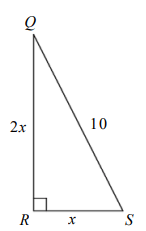
In the figure above, what is the area of right ?
(A) 4 √5 (B) 10 (C) 8 √5 (D) 20 (E) 40
Solution :
Using Pythagorean theorem :
x2 + (2x)2 = 102
x2 + 4x2 = 100
5x2 = 100
x2 = 20
x = √20
x = 2√5
Area of the triangle = (1/2) x base x height
= (1/2) x 2√5 x 2(2√5)
= √5 x 4√5
= 4(5)
= 20
So, the area of the triangle is 20.
Problem 10 :

In the figure above, if AD || BC, then x =
(A) 20 (B) 30 (C) 50 (D) 60 (E) 70
Solution :
In triangle DFC,
∠DFC = 180 - (60+70)
∠DFC = 180 - 130
∠DFC = 50
∠BFG = 50
∠FBG = 180 - (50+60)
∠FBG = 180 - 110
∠FBG = 70
x = 70 (corresponding angles)
Problem 11 :
What is the length of the hypotenuse of an isosceles right triangle with an area of 32?
(A) 4 (B) 4√2 (C) 8 (D) 8√2 (E) 3
Solution :
Area of the right triangle = 32
(1/2) x base x height = 32
base x height = 64
Since the given triangle is isosceles right triangle, two sides will be equal. In any right triangle, hypotenuse will be the longest side.
Let base and height of the right triangle be x
x2 = 64
x = 8
Using pythagorean theorem,
82 + 82 = (Hypotenuse)2
64 + 64 = (Hypotenuse)2
hypotenuse = √128
= 8√2
Problem 12 :
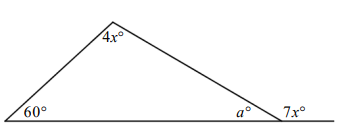
What is the value of a above?
Solution :
a and 7x are linear pairs.
a + 7x = 180 -----(1)
Sum of interior angles of triangle,
4x + 60 + a = 180
4x + a = 180 - 60
4x + a = 120 -----(2)
(1) - (2)
7x - 4x = 180 - 120
3x = 60
x = 60/3
x = 20
Applying the value of x in (2), we get
4(20) + a = 120
80 + a = 120
a = 120 - 80
a = 40
Problem 13 :
In shown above, if QS = 6, RS =
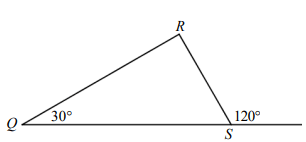
(A) 12 (B) 6√3 (C) 6 (D) 3√3 (E) 3
Solution :
∠RSQ = 180 - 120 ==> 60
In 30-60-90 right triangle,
QS = hypotenuse = 2 (smaller side)
2 RS = 6
RS = 3
Problem 14 :
The length of each side of a certain triangle is an even number. If no two of the sides have the same length, what is the smallest perimeter the triangle could have?
(A) 6 (B) 10 (C) 12 (D) 18 (E) 24
Solution :
Let 2, 4 and 6 are the three measures which are even numbers. To check whether these three measures will create a triangle, we will use triangle inequality theorem.
2 + 4 > 6 (False)
Then these three measures are not sides of the triangle.
4, 6 and 8
4 + 6 > 8 (true)
6 + 8 > 4 (true)
4 + 8 > 6 (true)
So, these three are the measures of the triangle. Finding its perimeter, we get
Perimeter of the triangle = 4 + 6 + 8
= 18
So, option D is correct.
Subscribe to our ▶️ YouTube channel 🔴 for the latest videos, updates, and tips.
Recent Articles
-
Finding Range of Values Inequality Problems
May 21, 24 08:51 PM
Finding Range of Values Inequality Problems -
Solving Two Step Inequality Word Problems
May 21, 24 08:51 AM
Solving Two Step Inequality Word Problems -
Exponential Function Context and Data Modeling
May 20, 24 10:45 PM
Exponential Function Context and Data Modeling